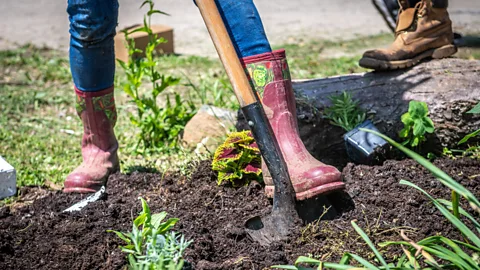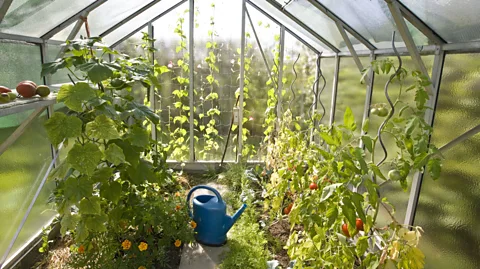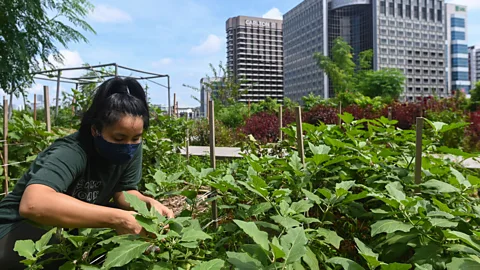The complex climate truth about home-grown tomatoes
 Getty Images
Getty ImagesAs spring gets underway, it's the ideal time to start growing veg at home. To make the most difference for the climate, some crops are especially worth growing.
You can tell these allotments have been here, on the Isle of Dogs in London, for a long time. Some of the sheds are former air raid shelters. "There's a lot of that still here from the war," says Paula Owen, a relatively recent arrival who has maintained her own plot for the last 10 years. "A lot of people make do and mend."
There are raised beds made of repurposed scaffolding boards. No heavy machinery. And hazel sticks for propping up tomato and bean plants. Somewhat incongruously, the giant glass and steel towers of Canary Wharf, London's shiny financial district, perforate the skyline to the north. But next door is a city farm, says Owen: "You can hear pigs and donkeys."
Owen and many like her see their allotments or urban gardens as low-impact, low-carbon contributions to their local community. A place where you can grow your own food, with no need for plastic packaging or planes that bring in produce from abroad. And so she was surprised to see reports of a study published in January 2024 that suggested urban agriculture in the US and Europe is on average six times as polluting, in terms of carbon emissions, as conventional, commercial agriculture.
One form of urban growing not included in the study was backyard or home garden veg growing. For collective gardens such as community-run gardens, specifically, the research suggested they were the most carbon-intensive of all – at 0.81kg of carbon dioxide equivalent (CO2e) per serving on average, versus 0.07kg of CO2e for conventional agriculture. Meanwhile, individual gardens – one person's allotment plot – were somewhere in between at 0.34kg of CO2e. Owen says she found the study "thought-provoking" but it left a sour taste. "It's a bit like David and Goliath," she says. "Why are they picking on the small guys?"
 Getty Images
Getty ImagesShe wasn't alone in having that reaction. As news of the study spread, social media was awash with prickly comments from gardeners disgusted at the idea that their much-loved veg patch could be harming the planet. PhD candidate Jason Hawes at the University of Michigan, lead author of the study, has received all kinds of comments about the work. He's had some "not so happy" emails, he confesses, but also conversations with gardeners genuinely interested in how to reduce the carbon intensity of what they do.
Hawes rebuffs insinuations from some on social media that the study was funded by commercial agricultural firms: "I can say unequivocally that that is not true." The paper lists funding sources as public institutions in multiple countries, for example the National Science Foundation in the US and the Economic and Social Research Council in the UK.
Hawes also grows his own veg at home in Tennessee. "At the end of the summer when we have way too many tomatoes, we'll make salsa," he says. "This paper was written by a bunch of folks who think that urban agriculture is really important."
What's the data, then, behind their seemingly disturbing results? To quantify the carbon footprint of conventional agriculture, the researchers scoured academic literature to find data on the five most-consumed fruits or vegetables in multiple countries. They considered things such as fertiliser use and the proportion of these crops typically flown in to a country rather than produced domestically.
For urban agriculture, gardeners across 73 small sites in the UK, US, Germany and Poland were tasked with keeping diaries or logging their methods and the infrastructure they use – such as raised bed materials. The urban agriculture category did not include vertical farms, which tend to be very energy intensive. (Read more about how far vertical farming can really go).
The results for conventional agriculture, relying on a huge range of data sources, were conspicuously narrow – everything settled on or around 0.07kg of CO2e per serving. Hawes says that this is actually unsurprising, given the economic pressures on the industry, which force it to be highly efficient. However, he accepts that it is "reasonable" to critique this comparison of urban and conventional agriculture samples, given that the samples for each are of such different sizes.
Also, to be clear, while the sample of 73 urban gardening sites related to 73 specific locations, the sample numbering 250 for conventional agriculture actually related to life cycle assessments, some of which may span multiple farms.
 Getty Images
Getty ImagesThe wider context to all of this is that roughly 5% of global greenhouse gas emissions come from the commercial production of crops grown for human consumption. Emissions from small-scale urban growers is almost certainly a tiny fraction of that – though they would also produce a far smaller total volume of food.
Hawes confirms that his and his colleagues' study did not consider the carbon footprint of a customer driving to a shop to buy fresh produce, nor the packaging that might be used for some fruit and veg in a retail environment. However, a generic value for emissions associated with supermarkets was included.
Hawes emphasises that the lowest carbon-intensities in the study were associated with a handful of highly sustainable urban agriculture sites and that this part of the analysis reveals that, by recycling materials for garden infrastructure, using the same equipment for many years, and avoiding synthetic fertilisers, it is possible to grow your own veg and have an extremely low carbon footprint.
Crops such as tomatoes and asparagus, which, in conventional agriculture, may be flown long distances or require energy-intensive greenhouse facilities, are especially good options for gardeners who want to grow their own while reducing their carbon footprint.
Still, Sally Nex, author of the book How to Garden the Low-Carbon Way, says she was "massively frustrated" by the study and news reports about it. "The problem is the headline that people take away from it," she says. "It puts people off growing their own vegetables."
She argues that many gardeners are keen to re-use, re-purpose and recycle, make their own fertiliser with plants such as nettles or comfrey, and use "no dig" methods to disturb the soil as minimally as possible, which helps lock carbon in the ground. Mulching, adding compost or wood chip to garden beds, for example, has the same effect. (Read more about How to turn your garden into a carbon sink).
A new generation of gardeners is emerging, asserts Nex. People who are sharply aware of the climate crisis and our fragile environment. "It's a sea change happening in gardening," she says. "The old 'peat, pesticides, plastic' model is dying away."
 Getty Images
Getty ImagesNex advises saving seeds from your plants to use during the next growing season in order to reduce as much as possible reliance on resources from outside. Veg growers could even lobby their local garden centres and ask them to stop selling compost containing peat, since harvesting this material from carbon-rich peatlands is highly unsustainable, Nex says. The UK government has promised to ban sales of garden compost containing peat by the end of 2024, though Nex notes that legislation to this effect is yet to be introduced to parliament. Plus, a ban on certain other peat-based garden products has been deferred to 2030.
Carbon count
The emissions from travel it took to report this story were 0kg CO2. The digital emissions from this story are an estimated 1.2g to 3.6g CO2 per page view. Find out more about how we calculated this figure here.
One point made by Owen is that there are many broader benefits of allotment-style gardening. It provides a community hub: "People will get together, they'll have tea and cake." One of the Isle of Dogs plots is maintained by a local school, she says. Another is used by patients in the area with various health issues – they spend time on the allotment as a nature-based intervention designed to improve their wellbeing.
A 2024 study analysed the biodiversity impacts of 39 community gardens in Munich and Berlin, in Germany, and found that these gardens were havens for threatened plant species as well as pollinators, especially wild bees.
The paper by Hawes and his colleagues does mention social benefits but he acknowledges that it leaves out other things, such as the virtues of taking ownership of one's food supply – otherwise known as food sovereignty. Hawes insists the study is not intended to demonise urban agriculture. The findings simply highlight the task at hand: "Urban agriculture, like many other things, needs to be planned and designed to be efficient in terms of carbon."
More like this:
Despite concerns over the methodology, Owen says she found the research interesting – and it did make her think about the impact of her own allotment plot. She uses locally sourced hazel sticks for making frames and obelisks, she saves seeds and bulbs from year-to-year, and regularly cleans and sharpens her tools so that they will last a long time. By growing some plants, such as sprawling pumpkins, up vertical supports, Owen maximises the productivity of her space.
If she went to the supermarket now to buy half a dozen apples, they would probably say "Kenya" on the plastic packet, she observes. But she won't do that. Instead, she'll turn to the box of apples kept cool and fresh in her garage. The dozens that she harvested and stored not long ago.
--
If you liked this story, sign up for The Essential List newsletter – a handpicked selection of features, videos and can't-miss news delivered to your inbox every Friday.
